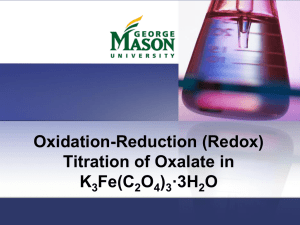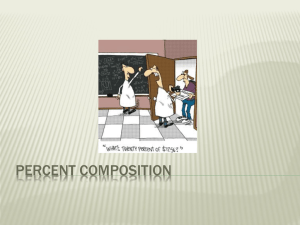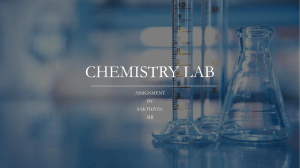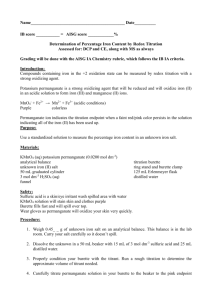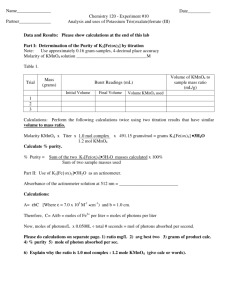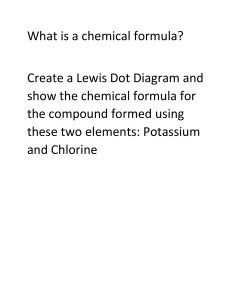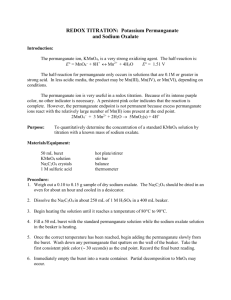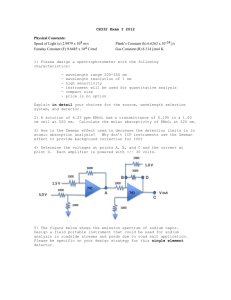Inorganic Chemistry Lab Report: Ligand Percentage Determination
advertisement
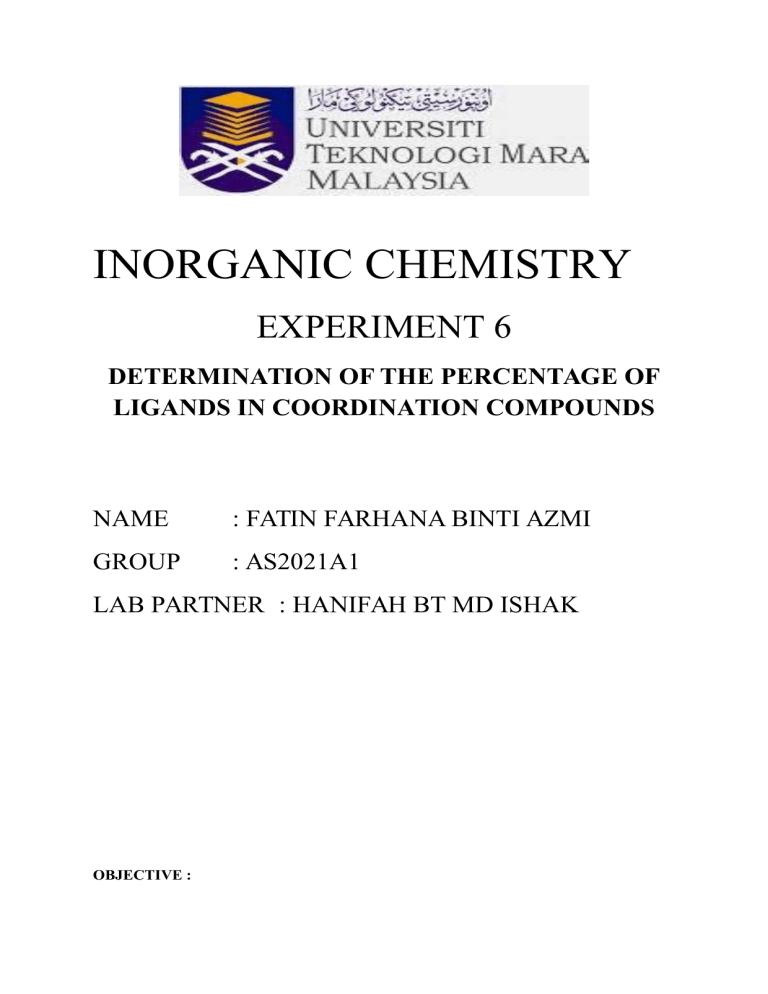
INORGANIC CHEMISTRY EXPERIMENT 6 DETERMINATION OF THE PERCENTAGE OF LIGANDS IN COORDINATION COMPOUNDS NAME : FATIN FARHANA BINTI AZMI GROUP : AS2021A1 LAB PARTNER : HANIFAH BT MD ISHAK OBJECTIVE : The purpose of this experiment is to determine the oxalate content in coordination compounds. THEORY : Titration is a common method for determining the amount or concentration of an unknown substance. The method is easy to use if the quantitative relationship between two reacting substances is known. The method is particularly well-suited to acid-base and oxidation-reduction reactions. In this experiment, you will conduct two separate redox titrations using a standardized permanganate solution. In the second titration, you will be trying to find the oxalate content in coordination compound. Permanganate ion is a powerful oxidizing agent, especially in acidic solution, which can be used to analyze (by titration) solutions containing many different species. In these titration reactions, the intensely colored MnO4- ion is reduced to form the colorless Mn2+ ion. CHEMICAL &APPARATUS : Sodium oxalate Sulphuric acid Potassium permanganate Distilled water Measuring cylinder Burette Retort stand Conical flask Beaker White tile Hot plate PROCEDURE : A)Standardization of potassium permanganate solution. 1. 2. 3. 4. Weight about 0.20g dried Na2C2O4 and transfer into a conical flask. Dissolve it in 50mL of 1M H2SO4 and heat the solution to 60oc. Put KMnO4 into a burette and titrate until the first persistant pink colour. Repeat the step at least once more and record the data. B)Determination of the oxalate content in coordination compounds. 1. Weight about 0.20g of the coordination compound that have been prepared previously. 2. Boil the sample with 50mL of 1M sulphuric acid in a conical flask. 3. Allow the solution to cool until the temperature about 60oc. 4. Titrate slowly with the potassium permanganate solution provided. 5. Continue until the warm solution retains a slight pink colouration after standing for about 30seconds. 6. Repeat the step at least once more to get consistent value and record the data. RESULTS : a)Data table for the standardization of KMnO4 solution Mass of sample (g) 0.2234g 0.2333g I II Final Burette reading (mL) Initial Burette reading (mL) 11.35 10.80 0.00 0.00 Volume of KMnO4 11.35 10.80 Burette reading Average mass = 0.22835g Average volume = 11.075 mL a)Data table for the standardization of KMnO4 solution Mass of sample (g) 0.2140g 0.2143g I II Final Burette reading (mL) Initial Burette reading (mL) 5.35 10.50 0.00 5.00 Volume of KMnO4 5.35 5.50 Burette reading Average mass = 0.21415g Average volume = 5.425mL QUESTION: 1)Given that MnO4- is being reduced to Mn2+ and C2O4- is being oxidized to CO2 ,write a balanced redox titration above.Use the equation to calculate the exact molarity of the potassium permanganate solution. MnO4- + 8H+ + 5e- K2SO4 + 2MnSO4 + 5Na2SO4 + 10CO2 +8H2O 2KMnO4 + 5Na2C2O4 + 8H2SO4 K2SO4 + 2MnSO4 + 5Na2SO4 + 10CO2 + 8H2O 0.22835 g 133.9985 g/mol No of mol Na2C2O4 = = 1.7041 × 10-3 mol 1 mol of Na2C2O4 = 1 mol of KMnO4 2 mol of KMnO4 = 2 × 1.7041 × 10-3 mol = 3.4082 × 10-3 mol Molarity of KMnO4 = 3.4082 ×10−3 mol 0.011075 l = 0.3077 M 2)Calculate the percentage by weight of oxalate in the complex , compare this with the theoretical value and thus obtain the percentage purity of the complex. No of mol KMnO4 = 0.3077 M ×( 5.425 × 10-3 L) = 1.6692 × 10-3 mol Theoretical yield coordination compound (K3[Cr(C2O4)3].H2O) = No of mol KMnO4 × molar mass of (K3[Cr(C2O4)3].H2O) = 1.6692 × 10-3 mol × 1083.4695 g/mol = 1.8410 g Actual yield coordination compound (K3[Cr(C2O4)3].H2O) = 0.21415g Percentage yield = = Actual yield ×100 Theoretical yield 0.21415 g ×100 1.8410 g = 11.63% 3) Predict and draw the structure of the synthesize compound DISCUSSION : The qualitative analysis of substances can be done by using a titration technique. It involves tow solutions, one is of known concentration and another is of un-known concentration. This process is based on some reaction between both known as unknown solutions such as acid-base reaction or redox reaction. Redox reaction can also be a basis of titration. We know that redox reaction are a combination of two reactions; oxidation and reduction reaction. The oxidation reaction involves increment in the oxidation state whereas in a reduction, the oxidation number of reactant molecules reduces by certain numbers. The substance that oxidised is known as reducing agent. On the contrary, the substance that reduces is known as an oxidising agent in the redox reaction. Experiment will be start by standardization of potassium permanganate solution. Weight about 0.20 g of primary-standard sodium oxylate, Na2C2O4, Dissolve sample in about 50 mL of 1 M H2SO4. Heat each solution to 60 °C, and titrate with KMnO4 . Fill your buret with the KMnO4 solution and drain out enough so that the liquid level is just below the upper calibration mark and the buret tip is full. Read the initial volume from the calibration scale on the buret. This reading and all other buret readings should be estimated to the nearest 0.01 mL. The color of potassium permanganate is so deep that you hardly can see the lower menisk. Use the upper one to read the volumes.The pink colour imparted by one addition should be permitted to disappear before further titrant is added.The temperature should not drop below 60 °C. The end point is marked by the appearance of a faint pink color. Correct the titration data for the blank, and calculate the concentration of the permanganate solution. Proceed the experiment by determination of the oxalate content in coordination compounds which is potassium tris (oxalato) chromium(iii) trihydrate , (K3[Cr(C2O4)3].H2O). Chromium(iii), the most stable oxidation state of chromium ,forms a number of complexes in which six monodentate ligands surround the cation octahedrally.Repeat all the step from heating the mixture till to the persistant of slight pink colouration after standing for about 30s. We obtained that the the exact molarity of the potassium permanganate solution is 0.3077 M.The theoretical yield coordination compound (K3[Cr(C2O4)3].H2O) is 1.8410 g and actual yield coordination compound is 0.21415g.The percentage yield of the compound is 11.63% . There are some preacaution that can be alert by doing this experiment .When add the permanganate directly into the oxylate solution (not down the walls ofthe beaker). Promptly wash down any KMnO4 that spatters on the walls of the beaker into the bulk of the liquid using a wash bottle. Finely divided MnO2 will form if the KMnO4 is added too rapidly and will cause the solution to acquire a faint brown discoloring. This is not a seriousproblem of sufficient oxylate remains to reduce the MnO 2 to Mn2+simply discontinue the titration until the brown color disappears. The surface of the permanganate solution rather that the bottom of themeniscus can be used to measure titrant volumes. Partial decomposition of the permanganate to MnO2 may occur if it remains in the buret for a long time. Clean the buret with a dilute sodium bisulfite solution. CONCLUSION : We obtained that the the exact molarity of the potassium permanganate solution is 0.3077 M.The theoretical yield coordination compound (K3[Cr(C2O4)3].H2O) is 1.8410 g and actual yield coordination compound is 0.21415g.The percentage yield of the compound is 11.63%
